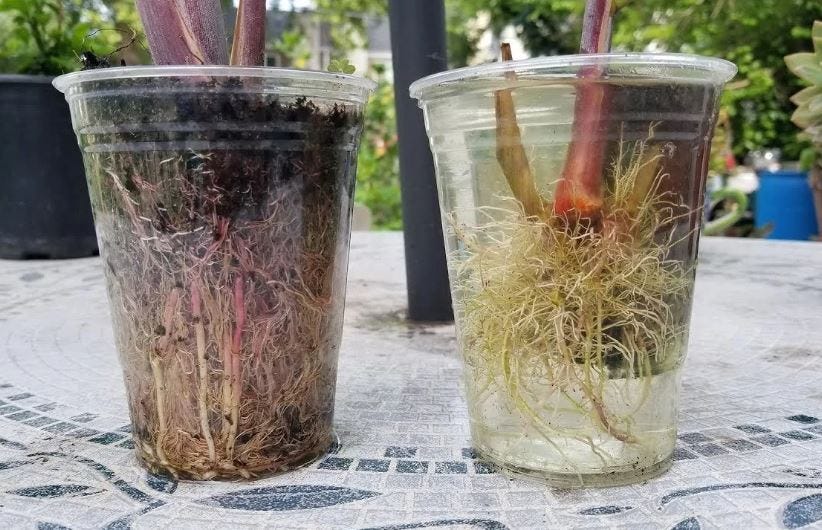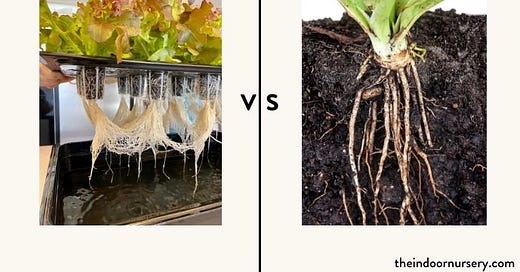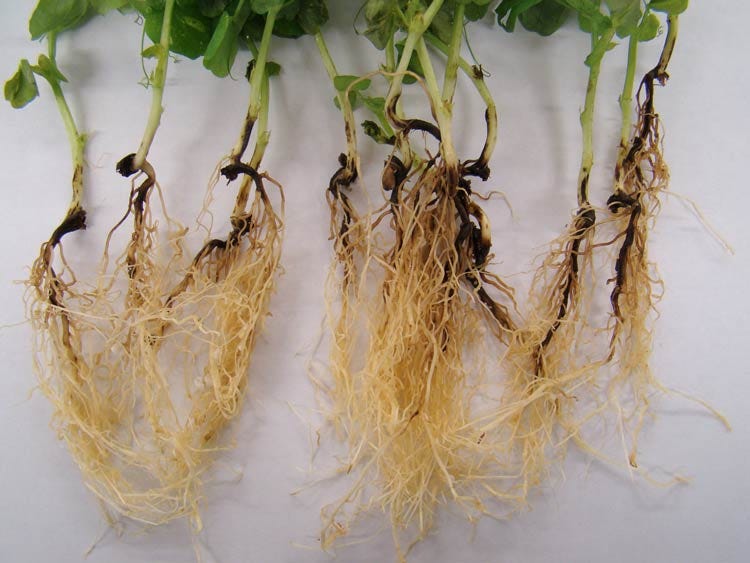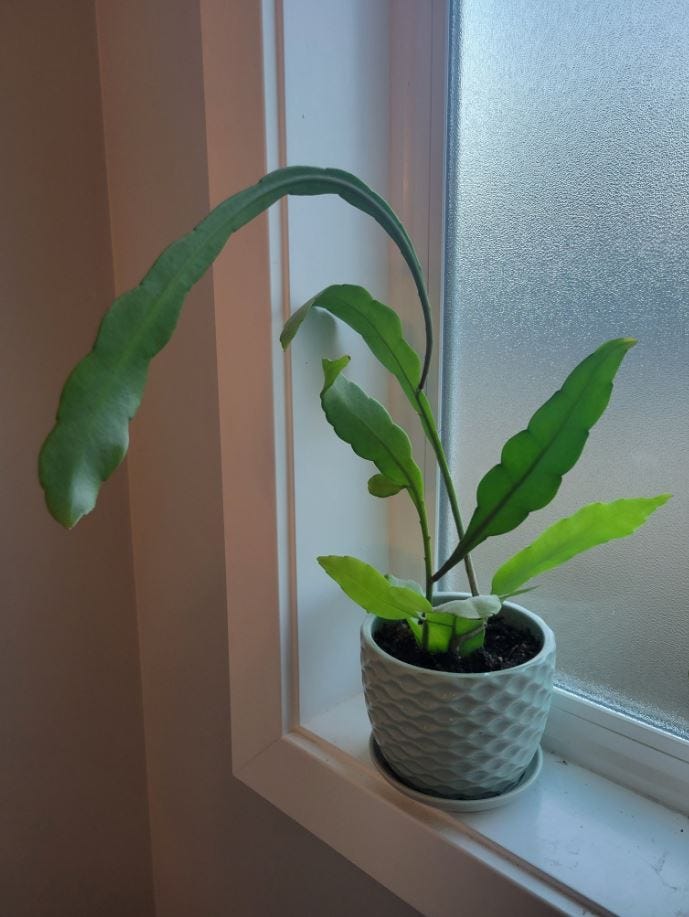Plants can grow more than one type of root? That’s right! Depending on how your plant was grown, it will develop the roots necessary to survive in its environment.
Since water propagations are such a popular method of growing and sharing plants, I wanted to break down the difference between soil roots and water roots so you can better understand your plant’s needs and give them the conditions required to thrive!
If you enjoy The Happy Planters Newsletter, please take 30 seconds out of your day to share this newsletter. It means the world to me and costs you $0. Thank you for the support!
Two Types of Roots
Water roots
These roots are usually a very light color, almost white, and have long thin strands. They can produce many little offshoots giving the roots an almost hairy appearance. The long, narrow structure of water roots makes them very fragile and can easily break when handled.
Water roots grow much faster than soil roots and require less space and energy to grow. They are designed to absorb nutrients from the water all around them, so they don’t have to grow as large to search for resources.
Soil roots
Soil roots, on the other hand, are much sturdier and have fewer thin offshoots than water roots. They will usually be a darker color and much harder to break.
They are designed to dig deeper and fight their way through the soil to access the nutrients for a plant to survive.
Notice the visual differences in the images below.

Why do roots rot in wet soil but not in water?
Soil roots are used to absorbing oxygen through pockets in the soil, and when submerged in water, they suffocate by not being able to absorb the oxygen they need.
On the other hand, water roots have many thin hairs that can absorb the oxygen out of water. This is why soil roots rot when waterlogged. They are not designed to absorb oxygen from water and essentially suffocate.
Also, there are more bacteria in soil that can harm the roots if they are not healthy. Our tap water is a very clean water source, and the chlorine used to treat our tap water prevents bacteria buildup and keeps the roots healthy.
How to Prevent Overwatering.
For soil roots, ensure you have breathable soil and allow it to dry between watering. Constantly wet soil is a breeding ground for bacteria and does not allow the roots to breathe.
For water roots, make sure you keep them in a very bright spot. I know this sounds funny since they sit entirely in water, but even with specialized roots, your plant will not be able to survive in water without enough light and will begin to rot.
Here is a picture of what root rot looks like. If you notice the roots turning dark brown or black, it means your roots are beginning to rot.
Can soil roots become water roots and vice versa?
Yes, they can! Well… most plants have the ability to make this transformation. Some dryland plants will die in this condition, but plants that have adapted to flood conditions, like rice, will transform quickly and thrive!
I have been experimenting with growing in water and have found that most of the common houseplants I have tried have lived after a transitionary period. Given enough time and the proper conditions, I have successfully moved soil plants to water as well as water propagations to soil.
The Best Way to Convert Your Water Propagations.
For paid subscribers only: Keep reading for this tip below the Happy Planter Submission of the Week :)
Final Notes
Plants are amazing and will do their best to survive in whatever conditions you put them in. Attempting to switch your soil plant to water can be a fun experiment! You will be able to see the roots changing from one type to the other.
A low-risk way of growing a plant in water is to start a water propagation and see how long you can keep it alive without ever transferring it with soil.
Lastly, Substack chat is a new feature that I will be implementing soon! It’s a group chat-type platform similar to Twitter, but for The Happy Planter Subscribers only!
I’m still looking into how to utilize this best for our community, but I think it would be a great place for questions and discussions between all of you and a place where I can be more interactive than on Twitter.
This Week’s Happy Planter Submission
This is my favourite houseplant, it's a queen of the night cactus. It started out from a little cutting that I was gifted, and has grown to over 2 feet tall in 2 years. It flowers only at night, and the flowers are gone by the time the sun comes up the next day. I think it's very beautiful and also somewhat sad.
Thanks for sharing, Steve C (@vanisle7)! I hope you have been lucky enough to witness a bloom on your cactus. What a cool experience!
EXTENDED SALE!
I got a request to extend my Cyber Monday sale, so I decided to open it back up for another 48 hours! Get 20% off until Wednesday night :)
Paid subscribers help support the large amount of work that goes into researching topics, experimenting with strategies, and writing content for these newsletters. If you enjoy these emails, I would be grateful if you would consider subscribing.
Your friend,
-Houseplant Hobbyist
For the paid subscribers only:
The Best Way to Convert Your Water Propagations.
Don’t wait too long to transfer your cutting. Once you see roots about an inch long, it’s time to plant them! Depending on many factors, this can take anywhere from a few weeks to a few months, so be patient. If given proper light, I would say you will have water roots about an inch long in 3-4 weeks.
Once you see a few roots an inch long, transfer them to a very airy soil mix. Mix anything you have on hand to make this as light and breathable as possible. Use perlite, orchid bark, pumice, or whatever other chunky mix-ins you have.
You need the water roots to convert to soil roots and not suffocate as they do so. Allow them to breathe!
When you water your newly potted propagation, thoroughly saturate the soil until it runs out of the drainage holes. Then let it dry before doing this again.
Bonus Tip:
Avoid water propagation altogether. Many plants do great being propagated in sphagnum moss or even do the semi-hydro method by adding leca to your water propagation. This will give the roots something to hold on to and can be an easier transition when you are ready to plant in soil.
There are many fun ways to experiment with propagations, and I plan to break down more of these in the future.
That’s all for now!
I will continue to improve these newsletters and add more exciting content as I go. If you have any suggestions, please let me know.
If you enjoyed this newsletter, I would love it if you could simply reply to this email and let me know you enjoyed it. I read EVERY reply!
Talk soon! Feel free to enjoy my content on Twitter until the next newsletter :)
-Houseplant Hobbyist












So interesting and informative! Thank you.
Interesting Newsletter!